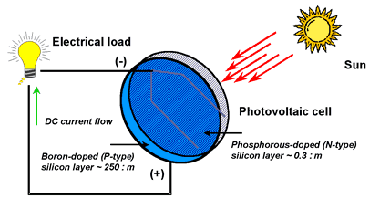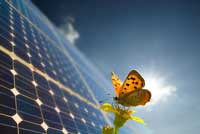|
What is photovoltaic? The word itself explains how photovoltaic (PV) or solar electric technologies work. The word photovoltaic has two parts: photo, a term derived from the Greek ‘phos’, which means light; and ’volt’, a measurement unit named for Alessandro Volta – a pioneer in the study of electricity. So, photovoltaic could literally be translated as light-electricity. And that’s just what it is: it converts light energy to electricity. Most solar cells are made of inert mineral materials – similar to sand. These cells convert light directly into electricity without moving or wearing parts. Silicon crystal cells have been in use since 1955 with space satellites and their life expectancy appears to be limited by the materials’ exposure to the elements, upwards of 20 years.
Have you ever wondered how electricity is produced by a photovoltaic cell? We’ll help you understand by covering the basics of PV technology.
Note: For you serious technogeeks, here’s some serious talk about how a PV cell works. For other less technically inclined people (and you are in the majority!); understanding how any of this works is absolutely not necessary to designing + installing a successful solar system… so skip this section and go to the ‘getting started’ section 5. When certain semi-conducting materials, such as certain kinds of silicon, are exposed to sunlight, they release small amounts of electricity. This process is known as the photoelectric effect. The photoelectric effect refers to the emission, or ejection, of electrons from the surface of a metal in response to light. It is the basic physical process in which a solar electric or photovoltaic (PV) cell converts sunlight to electricity. Generally speaking, photovoltaic solar cells use a semiconductor material that is exposed to sunlight. The energy of incident light striking this material displaces electrons from their normal atomic orbits onto an electrode grid structure on the surface of the semiconductor material which collects these electrons and makes them available for use in an external circuit. This is very similar to the way that the chemical reaction and electrodes in a dry battery cell make electrons available for external use. Figure 2 illustrates this process. The terms crystalline, thin film, and concentrator describe the manner in which the semi-conducting material is processed and optimized as a photovoltaic cell. Crystalline cells are fabricated from ingots of semiconductor material, usually silicon that are cut into relatively thin slices, processed to optimize the electron collection efficiency and laminated into a protective enclosure. Thin film cells are extremely thin layers of semi-conducting material that are evaporated onto a substrate, and concentrating cells use a plastic lens to concentrate sunlight from a large area onto a much smaller area of (mono or poly) crystalline semi-conducting material. A typical silicon PV cell is composed of a thin wafer consisting of an ultra-thin layer of phosphorus-doped (N-type) silicon on top of a thicker layer of boron-doped (P-type) silicon. An electrical field is created near the top surface of the cell where these two materials are in contact, called the P-N junction. When sunlight strikes the surface of a PV cell, this electrical field provides momentum and direction to light-stimulated electrons, resulting in a flow of current when the solar cell is connected to an external electrical load.
Figure 2: How a solar cell makes electricity Regardless of size, each typical silicon PV cell produces about 0.5 – 0.6 volt DC under open-circuit, no-load conditions. This is why you see multiple cells on a PV panel to produce 12 VDC. The current (and power) output of a PV cell depends on its efficiency and size (surface area), and is proportional the intensity of sunlight striking the surface of the cell. For example, under peak sunlight conditions a typical commercial PV cell with a surface area of 160 cm2 (~25 in2) will produce about 2 watts peak power. If the sunlight intensity were 40 percent of peak, this cell would produce about 0.8 watts. Most solar PV panels have an efficiency between 10-15%. The U.S. Department of Energy has produced a video (4 mb) of how a PV cell works. Take a look: http://www1.eere.energy.gov/solar/video/solarcell2.mpg
here are many types of PV modules available; however each PV module consists of 4 basic components:
The major variation between panels is the energy collecting surface. Most PV panels are either poly- or mono-crystalline. The top protection cover is usually made of some solid translucent material capable of withstanding high winds, hail, sleet, and snow. The enclosure, frame and mounting hardware are important in securing a PV panel to a roof or other surface. Use of proper panel mounts specifically designed for solar panels are essential to good installation practices and in preventing wind or other weather damage. Electrical connections to solar panels vary by PV panel manufacturer. These are further discussed in Section 7 – Electrical systems.
 |











